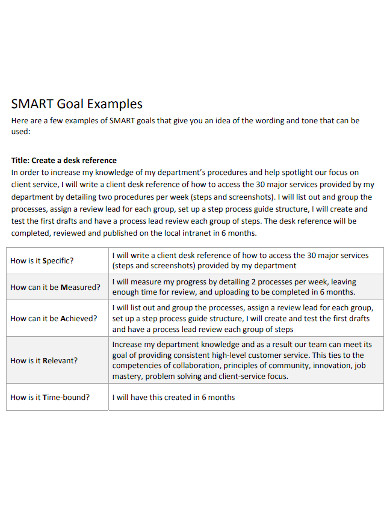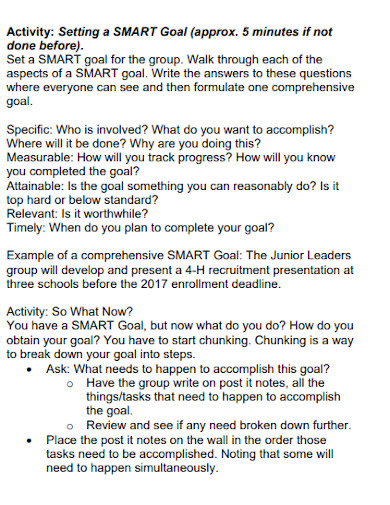Leadership Smart Goals Examples
How do you define a leader? Many of you may say someone who is able to lead a group. Some may even say a person who has a lot of experience in their fields. As John Quincy Adams once said that if the actions you do inspire others to dream even more, to learn even more, and to become more than who they are, then you are considered a leader. When it comes to being a leader, one must have a set of skills, as experience is not always going to be a component that would be recognized as a leader.
This goes for anything and everything, even your goals have to at least be seen as a skill made by leaders. As we all know, each and everyone of us has a set of goals that we wish to accomplish, and of course even leaders have them. But what does it take to make a good leadership goal? If you are planning on making a leadership goal, I suggest you make a SMART goal for leaders, or as we would call it a leadership SMART goal. It could be made for your company, for nurses or even teachers. What’s stopping you from checking these 4+ leadership SMART goals? Come on!
4+ Leadership Smart Goals Examples
1. Self Advocacy Leadership Smart Goals
2. Formal Leadership Smart Goals
3. Leadership Smart Goals Example
4. Leadership Breaking Down Smart Goals
5. Simple Leadership Smart Goals
What Is a Leadership SMART Goal?
What is a leadership SMART goal? What is a SMART goal? Before we proceed as to what a leadership smart goal is, let us first define what a SMART Goal is. We know that a SMART goal is an acronym and it means Specific, Measurable, Achievable, Relevant and Time Managed. A leadership SMART goal is a type of goal that is thought out and planned carefully.
Used mostly by managers or supervisors for their companies, a leadership smart goal consists of the objectives that they wish to see an improvement on their employees’ output. A set of goals is then planned to be accomplished and to improve on skills and to hit the parts that need improvement for the whole team.
Key Components Of a SMART Goal
Have you ever wondered what the key components of a SMART goal is? What makes a SMART goal smart? What does one have to know before they are able to write out their own goals in life? Let’s check the ones below right now.
1. Specific
Specific. What does it mean? If you look it up in the dictionary, it would mean to be clear. But when we think about your goals, this would mean that your goals have to be as specific as possible. What do you want to attain? What do you want to achieve when you plan out these goals? Having a vague goal will not get you anywhere. As much as possible understand what you want to achieve before planning on everything.
2. Motivational
Your leadership goals must also be measurable. This means that you understand what you want to see, feel and hear when you are able to attain the goal you have planned. For this case, the goals you are setting up for yourself or for your team, you must be able to expect what you planned out. In a way that you are already expecting all these to happen. As long as your expectations are also realistic.
3. Attainable
Just as you need to make the goals as specific as possible, you must also make them attainable. This means avoid making impossible goals. Impossible goals will not only make you lose interest or make you disappointed, they would also make you feel as if this may not be as what you expected it to be. Make all goals either personal or for your team attainable. Impossible goals do not count as goals. They are not only time consuming, but they are also irrelevant.
4. Relevance
Ask yourself, how relevant your objectives and goals are before making your SMART goal. Whether it may be personal or for your team. If your ideas help out the whole team in achieving the general goal, then make it happen. If however your goal has no relevance whatsoever to your leadership goal, do not add it. It would only make it less appealing for your team. This is why the most important thing you can ask yourself is how relevant is this objective or idea to your goals.
5. Time-Management
Last but not the least, your goals must be time-managed. This means that any kind of goal that you do must be done within a certain amount of time. No goal must be left hanging or left without any time or date placed. There will always be a time limit for any goal that you do, regardless if they are short term, long term or a lifetime goal. Always remember that your SMART goals require these five components to make it work.
How To Write a Good Leadership SMART Goal?
It’s time to know how to write a good leadership SMART goal. Seeing as we are done with the components of a SMART goal. Here are the tips on how you can start writing out your own leadership SMART goal.
1. Define Your Objectives
The first thing you have to do is to define your objectives. Your objectives must match what you plan on doing and your goal in general. A good objective or objectives consist of careful planning and well thought out ideas that benefit not only yourself but for the entire organization as well. Write down at least three of your objectives and make sure that they target the necessary goal you want to achieve or the category you want to improve on.
2. Place a Specified Date for Each Goal You Plan
Once you have completed defining your objectives, it is time to place specific dates for each of your goals. The reason for doing this is to make sure that you are able to manage your time and to be able to put a deadline for each of the goals you plan on achieving. Of course, the dates of your goals should also be realistic. It is quite impossible to complete a goal within the span of a few days especially if your goals are long term or lifetime goals. Realistic goals need realistic times and dates placed.
3. Your Goal Must Have Some Relevance
Just as what was written above, your goals and everything necessary in your goals must have some relevance with each other. The reason for the relevance is to make sure you understand what you are doing and you understand the importance of your goal and attaining them at a certain point.
4. Do a Trial Test for Your Goal
To be able to know if your goal is reachable, do a trial test. Ask a few people to participate and check. In a way that you are doing an assessment with your group goals. This is to see if what you have written in your objectives are attainable. Through the assessment and the evaluation, you are able to see if your goals do follow the SMART concept. If they do not or they do, the next step is still necessary.
5. Revise Your Goals When Necessary
Lastly, be open for revisions on your SMART Goal. If you are able to improve on your objectives and list, then you are able to revise on your goals when necessary.
FAQs
What is a leadership SMART goal?
A leadership SMART goal is a type of goal done for the benefit of the leader and their teammates. This type of goal is made to show any improvement on the areas that need improvement and the areas that need to be tackled to give better performance for the whole organization.
What does SMART in SMART Goal mean?
The acronym SMART means Specific, Measurable, Achievable, Relevant and Time-Management. These are the components of a SMART Goal.
What should be avoided when doing a leadership SMART goal?
Avoid making unrealistic goals. They go against the concept of a SMART Goal.
This is the end of the talk about leadership SMART goals. Whatever type of goal you may want to achieve or do, always make sure that you follow the SMART way. Not only will it make your life easier, it would also give you a higher chance of achieving that goal.







